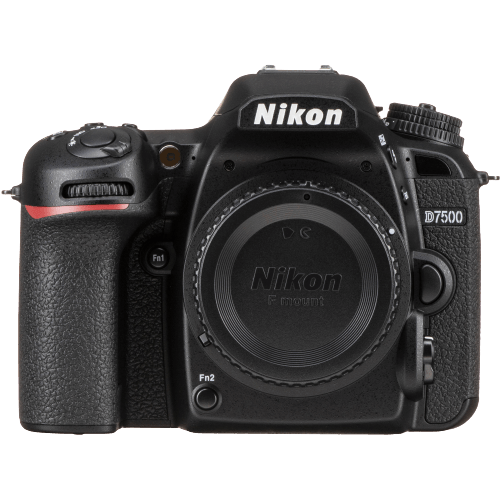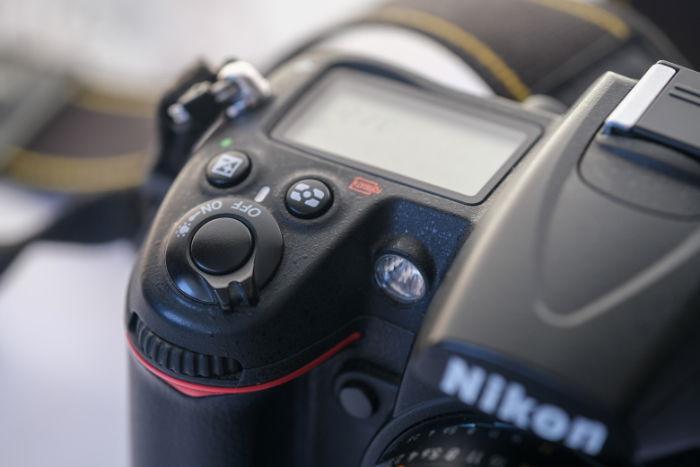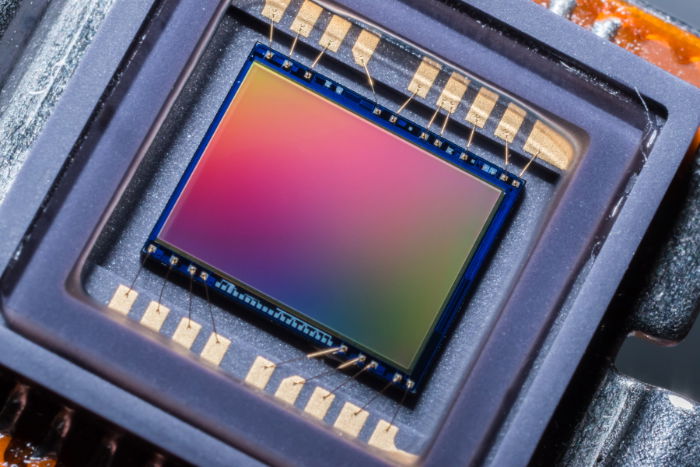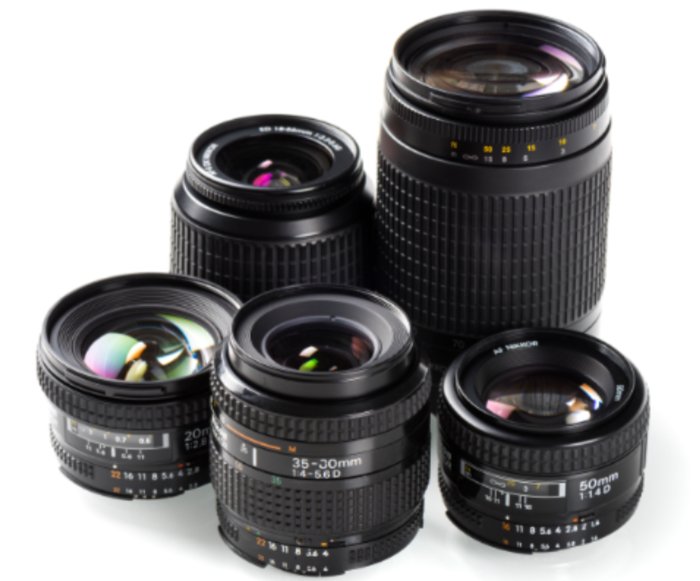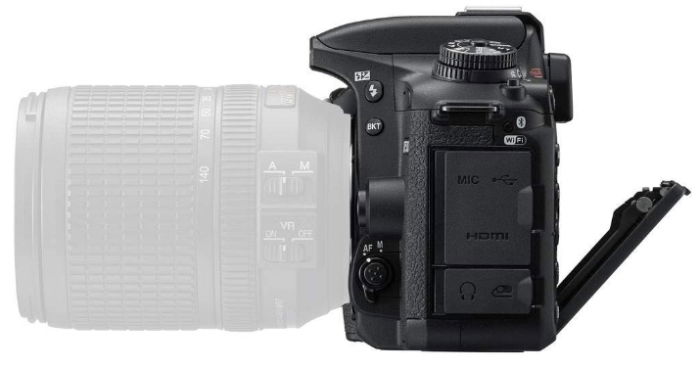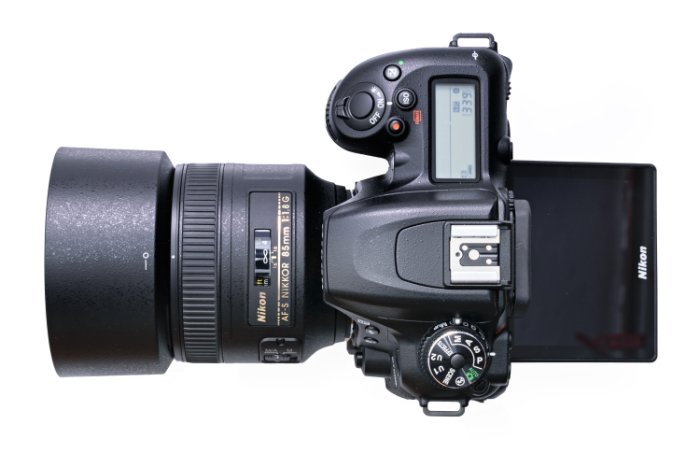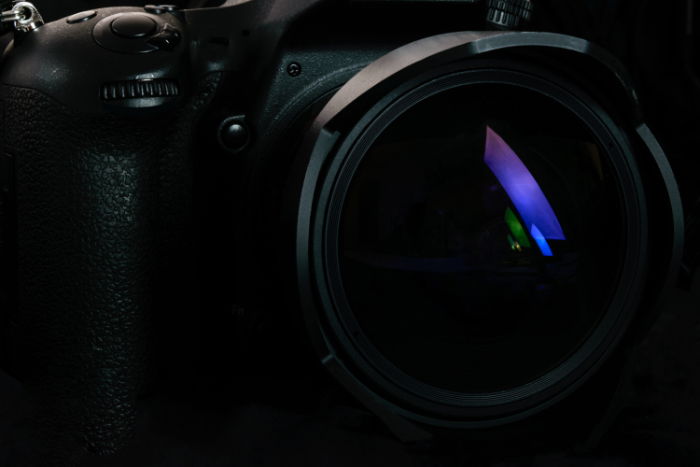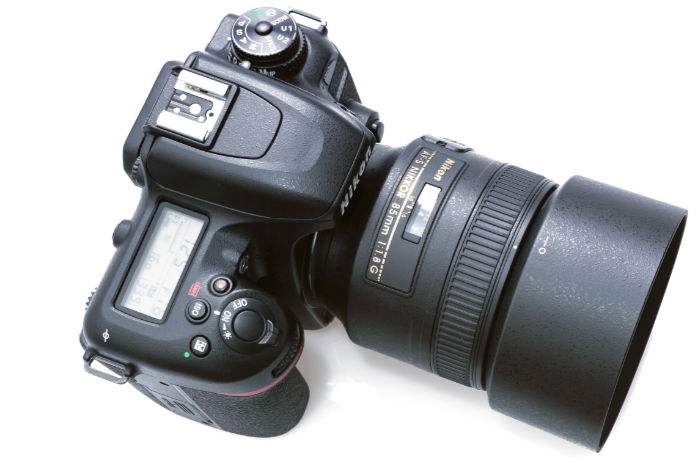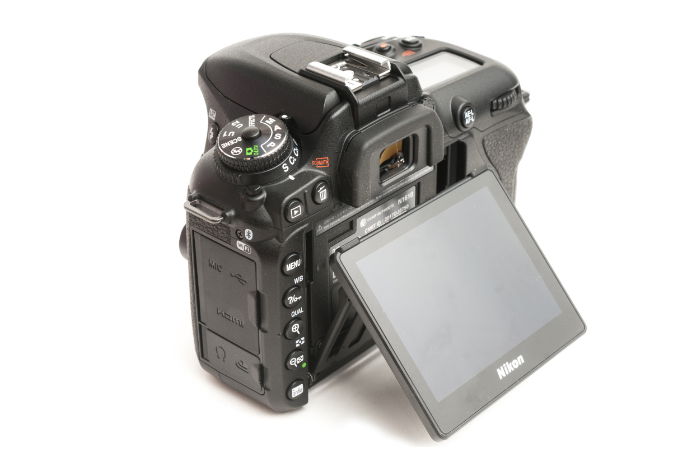The D7500 sits in a pretty competitive segment of the market. It’s not pro-level, but it’s also a bit pricey for just taking your holiday snaps. The competition comes from Nikon’s own stable but also all the other major players. It also is in the mix of the DSLR or mirrorless camera debate. In fact, most of the body-only cameras around the same price as the Nikon D7500 are mirrorless cameras. So it’s important to see if Nikon has got the right mix of features and specs. Read on to see if this capable camera is still worth buying.
Overview of the Nikon D7500 DSLR
The Nikon D7500 is a midsize DSLR camera. It has a 21 MP APS-C sensor and takes Nikon F-mount lenses. There is a tilting touch screen at the rear, Wi-Fi, Bluetooth, and 4K video. One of the more eye-catching specifications is the 1,640,000 ISO upper limit on expanded sensitivity. But more on that later. The D7500 replaced the D7200 and introduced several upgrades along the way. Continuous burst shooting speed improved from 6 to 8 fps. The metering sensor got a boost from 2k to 180k, which is quite the jump. The rear screen became tiltable and touch-sensitive, and the camera now offers 4k video shooting. Albeit with a 1.5 crop factor. But there were also some perceived downgrades. Some of those perceptions may be justified, others perhaps not. First of all, the image sensor. The D7200 had a 24 MP sensor. Its replacement only sported a 21 MP chip. Now, this sensor is actually the same sensor as the one found on the more expensive Nikon D500. This camera is the flagship Nikon APS-C DSLR. The next stop is the full frame D610 for about the same money as the D500. So, it makes sense not to offer a “better” sensor in the cheaper camera. I’ll look in more detail at the image sensor size in that section of this review. Secondly, the D7500 only has one SD card slot. The D7200 before it and the more expensive D500 have two. Perhaps the choice is to put some clear water between the D7500 and the D500. Perhaps it’s an inevitable cost-saving now that cards are almost invariably reliable. Still, it would be a surprise to see a professional camera going to one slot. Too much is riding on it.
Who is the Nikon D7500 Good For?
First of all, if you have any Nikon F-mount lenses, then this would be an obvious camera body for you to consider. The D7500 doesn’t meter properly with old manual focus lenses, but they will still fit. Secondly, if you are looking for a better-than-entry-level DSLR camera that won’t appall your bank manager, consider the D7500. Even if you’re quite new to photography, the D7500 will be good while you learn. From fully auto to fully manual, it will see you through. Finally, this will satisfy anyone, even up to professional standards. True, it is not full frame. Where this tends to matter is if you can’t get close enough to the action and have to crop heavily. Or if you are doing gallery-size prints of fine detail landscapes. Otherwise, the crop sensor might not matter. In the food and real estate markets, four agencies I have worked for demand full frame cameras from their photographers. But I think this is more about weeding out hopefuls than picture quality.
Nikon D7500 Specifications
We’ve said a little bit about the specs of the D7500. Let’s look at some of those in more detail now.
Mount and Compatibility
At first glance, the Nikon F-mount is a triumph of longevity. It was first introduced in 1959. And the one found on Nikon DSLRs now is theoretically still the same. Of course, this isn’t true in practice. The mount has complex features to allow communication between the camera and the lens. However, there is a lot of backward compatibility with the D7500. It will work with all Nikkor AF lenses from about 1986. Manual lenses can’t communicate their aperture to the D7500, so they won’t be able to make AE readings. The mount has a 1.73-inch (44 mm) diameter throat and a 1.83-inch (46.5 mm) flange to focal plane length. One key difference between Canon and Nikon lens mounts is their interchangeability. Canon’s APS-C mount, the EF-S, will accept EF lenses. The EF-S lenses will not fit EF cameras. Nikon DX lenses (their APS-C lenses) will fit their full frame cameras. But there will be some cropping, usually at wider angles. That 1986-onwards compatibility means that there is an absolute forest of lenses out there. New and used, and of every shape and form. There’s a lot to be said for Nikon’s own Nikkor lenses, as they often come with forward-looking compatibility. It makes sense. Nikon engineers know what is in the pipeline years before it makes it to the market. So a Nikkor lens might be ready for features not yet available on any cameras.
Sensor and Image quality
I’ve mentioned already that some eyebrows migrated northwards when Nikon announced the specs for the D7500. That reduction in sensor size was a talking point. A new camera with fewer pixels seemed a bold or foolish move. But more pixels aren’t always better. This is partly because an increased pixel count can increase noise. And partly because those pixels have to inhabit the same area. So they are smaller and more tightly packed. And also, a lot of the time, you don’t actually need any extra definition that a higher pixel count might bring. The average Nikon D7500 user is not going to be making gallery-size prints for display. What you gain by reducing the number of pixels is the speed of processing. And that is likely to be more useful, day-to-day, for most people. So the D7500 gets those extra two frames-per-second continuous shooting speed. And it can buffer JPEGs at that speed for more than a hundred shots. That’s a good 12 seconds or more with your finger on the shutter button. Like I said earlier, another eye-catching statistic was the maximum ISO. This is now 1,640,000. While the eye is caught, will it be pleased? To be frank, probably not. Don’t think you’ll be able to roll off great pictures with the ISO set to over a million. You will most likely be disappointed. Does this mean that the Nikon D7500 performs badly in low light? Absolutely not. The image quality all the way up to 25,600 ISO is impressive. It retains detail, and you can lift the darks to reveal surprising levels of clarity. This is thanks to the quality of the sensor, even if it is slightly smaller than the D7200. Part of the reason for this impressive performance is the strong dynamic range of the sensor. At over 13 EV at ISO 100, it is on par with much more expensive cameras like the Canon EOS R6. It also demonstrates a good deal of ISO invariance. ISO invariance is something I’ve only recently fully understood. When it’s present, you can expose for the highlights in a photo without losing the details in the shadows. This means you can even recover usable photos from underexposed photos. Try it. Find a photo you had not bothered with because of underexposure. Then open it in your editing software and increase the exposure. With RAW files, you might well find you have rescued the shadows. With the added bonus of avoiding blown highlights. All this is by way of saying that the Nikon D7500 delivers great image quality. And it does it across a wide range of situations. Auto white balance works reliably in most lighting types. This becomes more varied as the brightness reduces. But in most circumstances, you can forget it and let the camera do its work. The sensor also provides 3-axis electronic stabilization, which we’ll look at more in the video section.
Focusing and Burst
Nikon D7500 with the screen extended” width=”700″ height=”467″ /> © WDnet Digital Creation Studio (Depositphotos.com) We’ve already seen that the smaller sensor is faster than the D7200. It inherits both the sensor and the processor from the D500. The added speed is definitely a bonus for fast-action photography. But there’s no point in being able to take eight photos per second if the autofocus can’t keep up. So how does the Nikon D7500 AF fare? The short answer is “very well.” Perhaps not surprising as the metering sensor used for AF is the same as that used on Nikon’s $6500 then-flagship D5 full frame camera. It also shares the same EXPEED 5 processor. There’s no increase in the 51-point AF points. But the data from these points benefit from the advanced processing. The AF uses both contrast detection and phase detection. The phase detection is not on-sensor, though. So in live video, it will rely on contrast detection. You can choose AF points by region or individually. There are fifteen cross-type sensors grouped around the center of the screen. The rest are horizontal. The D7500 is the first Nikon APS-C to offer effective 3D tracking and face detection. This impresses with both its speed and accuracy. Even in low light, the AF and tracking are quick and accurate. Nikon says the AF will work down to -3 EV. That’s roughly a full moon. Or a 60-second exposure at ISO 100 with an f/2.8 lens. That’s pretty dark. In the real world, this means that you can be pretty confident that the camera will keep your chosen subject in focus. Even if you are firing away at maximum speed. Whether that’s pitchside at the football match or the bride walking down the aisle.
Video Features
Nikon D7500 might not be on your shortlist.
Body and Handling
I know looks aren’t everything, but the Nikon D7500 is a good-looking camera. The body is bigger than an entry-level DSLR. But it doesn’t have the bulk of a pro-level camera. There’s no manganese chassis but a carbon fiber composite. But the body is weather sealed and has a secure-feeling textured grip. The right-hand grip is nicely-sized, with the shutter button and main power switch. The top of the camera is uncluttered and business-like. There is an LCD status screen with basic information. I don’t find it as clear nor as informative as you find on comparable Canon cameras. But then other cameras (like the Canon EOS R6) have ditched it altogether. The combined mode dial and release mode dial are to the left of the pentaprism. The rear of the camera shows the dilemmas faced by manufacturers. The tilting screen allows space along its left edge for five buttons. With a fully-articulating screen, you lose that option. So the lack of articulation means that the buttons available to the right thumb are fewer and less likely to get in each other’s way. The screen itself tilts both up and down. This makes high and low shooting positions better. Gestures that are familiar to us from our smartphones, such as pinch and flick, work as you’d expect. You can touch to focus and meter in live view mode. And you can also activate the shutter. Two scroll wheels allow easy control of the various functions. Depending on the mode, this might be shutter speed or aperture. One, the main control dial, falls under the right thumb, with the combined AE and AF lock button nearby (but out of the way). The other, the sub-command dial, is in the shutter release button shroud for the index finger. Also accessible to the right thumb is the four-way multi-selector. Two customizable function buttons are on the front of the camera and are accessible to the right hand. The manual focus switch is on the other side of the lens mount (for lenses without an integral switch). Finally, surrounding the pentaprism is the pop-up flash. And to the right of the viewfinder eye-cup is the diopter adjustment dial. The optical viewfinder is 0.94 magnification. It provides 100% coverage both horizontally and vertically. The viewfinder information is comprehensive—exhaustive even. In fact, the manual lists no fewer than 29 separate items that are shown in the viewfinder. All-in-all, the Nikon D7500 shows its pedigree as a camera made by a manufacturer with decades of experience. It strikes a neat balance between available complexity and ease of use. This is perfect for the target user—someone who doesn’t want the weight and complexity of a pro-level DSLR. But who also wants flexibility and access to creative options. <img class=”wp-image-845650 size-full” title=”Stock photo of a close up of the Nikon D7500 top screen” src=”https://expertphotography.com/wp-content/uploads/2022/08/nikon-d7500-review-2022-top-closeup.jpg” alt=”Stock photo of a close up of the Nikon D7500 top screen” width=”700″ height=”467″ /> © WDnet Digital Creation Studio (Depositphotos.com) In use, the Nikon D7500 seems to suit many people. The controls are well-placed. There are good customization options if you want to get technical. Or you can set everything to Auto and just snap away. One thing that makes you wonder if Nikon really was leaning more toward the casual user is one of the glaring omissions with the D7500. There is no provision for a battery grip. As a keen battery grip user, from the days of my first entry-level DSLR, this seems like an odd choice. The battery life on the Nikon D7500 is very good, but a battery grip isn’t just about prolonging shooting times. After all, it doesn’t take too long to swap a battery. But it really makes a difference when using the camera in a vertical orientation. So it is a decision that was questioned by quite a few people when the D7500 was released.
Alternatives
The Nikon D7500 finds itself in an interesting price bracket regarding the competition. It depends on where you live. But at the same point, or thereabouts, you can find:
Canon EOS 6D Mark II full frame Sony Alpha a6400 mirrorless camera Olympus OM-D E-M5 Mark III Micro Four Thirds
This can make things complicated if you’re not certain what you want. These three cameras are all excellent in their own way. And if you’re a regular reader, you’ll know that compromise is usually part of what we do when we choose a camera. For instance, the EOS 6D Mark II has a fully-articulating screen, which might win you over for your needs. Or you might be persuaded that the almost faultless video AF on the Sony Alpha if that’s what you need. Or, a compact, landscape-capable camera might be on your list. In this case, the Olympus OM-D E-M5 Mark III is worth a look. My advice would be to draw up a list of what your needs, wants, and preferences are. Then compare what’s available.
Our Verdict
The Nikon D7500 is a fine camera. It has many features to make it attractive to the hobby photographer who wants something better than an entry-level DSLR. You might like the clear and informative optical viewfinder. Or the better-than-average burst speed. The articulating rear screen is a benefit for video and some photography situations. But the video is let down by slow autofocus. The D7500 replaced a very capable Nikon DSLR, and it fits well below the more expensive D500. Its low-light performance and general build quality make it a solid choice for a range of photographers.
Scores
